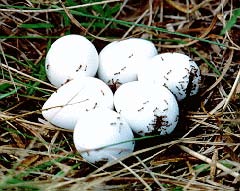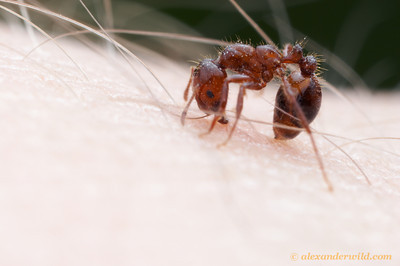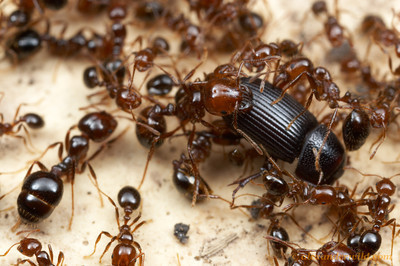Interactions
Because Solenopsis invicta is an
“invasive” species, it is implied that this is a harmful or
disruptive species. Indeed, these ants do have quite a large
negative impact on many other organisms. Although conducting
experiments to discover long term impacts on
different species on a large scale is difficult, small scale
observational studies can be very informative (Allen et al.
2004).
Small animals are at high risk for being negatively affected
by S. invicta, especially ground nesting organisms
(Smithsonian Marine Station 2007). Reptiles are prime examples,
because the adults do not provide proper care to their young if
their nests have been infiltrated by RIFAs (Allen et al. 2004). Snake and amphibians are
also in this same situation, although much attention has been
focused on sea turtles. According to a study performed in
2009, Loggerhead sea turtle eggs are especially susceptible to
being breached by foraging ants (Diffie et al. 2010). RIFAs
will sting and eat hatchlings, which overall devastates sea
turtle populations (Allen et al. 20 04).
Birds, such as doves, terns, and northern bobwhites have also
been found in lower numbers in invaded areas, and small
mammals are also profoundly impacted. These mammals have far
lower species richness in infested areas than their
counterparts in unaffected regions (Allen et al. 2004).
04).
Birds, such as doves, terns, and northern bobwhites have also
been found in lower numbers in invaded areas, and small
mammals are also profoundly impacted. These mammals have far
lower species richness in infested areas than their
counterparts in unaffected regions (Allen et al. 2004).
Red Imported Fire Ants also affect native ant species. Areas
with small populations of RIFAs and higher diversity of other
ant species show that competition may occur, although studies
also show native ant species and RIFAs can coexist (Cumberland
and Kirkman 2012). Human involvement in the eradication of
S. invicta has actually caused greater strife between
native and invasive species than actually occurs in nature. Air
sprayed with pesticides in the southeast United States was an
attempt to kill off the invasive RIFAs, but also killed off
native ants. The harmful pesticides actually caused more
devastating distresses (Encyclopedia of Life 2013). The RIFAs, being
more efficient at reproduction and colonization, recovered
faster than native species, therefore becoming more dominant and
worsening the problem (Gordon 2010). The native ants did
recover, but human contribution did not help the situation which is still a struggle to this day.
Humans have been working towards getting rid of the pesky Red
Imported Fire Ants across the globe, especially in the United States since they were
accidentally introduced from South America about a hundred years
ago (Encyclopedia of Life 2013). However, most attempts have been
futile. RIFAs have been responsible for substantial crop
damage. The Department of Agriculture has estimated that these
ants have cost about 6.5 billion dollars between damages and
control of population (Smithsonian Marine Station 2007). To
learn more about the economic impact of S. invicta,
please visit
http://entoplp.okstate.edu/ddd/insects/rifa.htm.
Besides
crop damage, RIFAs are simply an annoy ance. The venom of
Solenopsis invicta unique in that fact that is contains
95% alkaloid and only a small amount of protein, while most
other ant and wasp venoms contain little to no alkaloid.
This toxic special property of the venom causes a very
unpleasant reaction in victims (Taber 2000). Even slight contact of skin
with a nest will lead to a plethora of stings, which are very
painful (Gordon 2010). The pustules that form are necrotic,
causing cells to die, due to the poisonous venom which the ant
releases when it stings (Klotz et al. 2008).
ance. The venom of
Solenopsis invicta unique in that fact that is contains
95% alkaloid and only a small amount of protein, while most
other ant and wasp venoms contain little to no alkaloid.
This toxic special property of the venom causes a very
unpleasant reaction in victims (Taber 2000). Even slight contact of skin
with a nest will lead to a plethora of stings, which are very
painful (Gordon 2010). The pustules that form are necrotic,
causing cells to die, due to the poisonous venom which the ant
releases when it stings (Klotz et al. 2008).
However, Red Imported Fire Ants aren't solely pests. Some
colonies actually have a mutualistic association with plants.
The plant provides space for a nest to form as well as
nutritious nectar, while the ants protect the plant from
herbivores (Gordon 2010). As mentioned in The Southwestern
Naturalist, specifically there is facultative mutualism between
RIFAs and a particular type of legume, Senna occidentalis (Fleet
and Young 2000). Large colony size and large individual ants
ma y provide an even better form of protection for these legumes
(Fleet and Young 2000).
y provide an even better form of protection for these legumes
(Fleet and Young 2000).
Within colonies, RIFAs interact and communicate via
chemicals known as pheromones (Taber 2000). Ants also
use “recruitment” pheromones as a trail for other ants to follow
in order to find a food source (Taber 2000). RIFAs are
foragers and predators, feasting upon anything from seeds, to
termites and miniscule invertebrates, and scavenging on dead
organisms (Asano and Cassill 2012). The image to the right
clearly depicts how aggressive RIFAs can be when hunting for
food. To view even more photographs of the fascinating
S. invicta , click here to
visit the gallery.
Click here to return to the home page.
